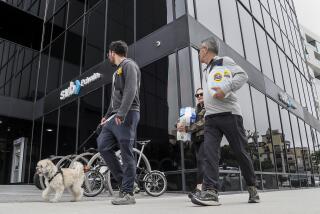S&L; Rescue Bill Setbacks : Home Fed to Pursue Charter Status
- Share via
Despite provisions in the savings and loan rescue bill that will make the conversion more costly than originally planned, Home Federal Savings & Loan said Monday that it intends to press on with efforts to become a state-chartered commercial bank.
In an interview Monday, Home Fed President Robert F. Adelizzi made it clear that maintaining the high profits of the S&L;’s widespread real estate developments is a primary reason for following through on the conversion plans.
Last week, Home Fed received Federal Home Loan Bank Board approval to quit the bankrupt Federal Savings and Loan Insurance Corp. fund. The approval was viewed as Home Fed’s biggest hurdle in its two-year effort to escape paying special premiums instituted by the FSLIC four years ago. The special assessments were levied to bolster the fund depleted by the failure of hundreds of S&Ls; in recent years.
Home Fed last year paid a basic FSLIC premium of $9.6 million and a special premium of $13.7 million, for a total FSLIC bill of $23.3 million in 1988. A successful switch to the Federal Deposit Insurance Corp., which insures bank deposits, would cut Home Fed’s deposit insurance bill to an amount roughly equal to the basic FSLIC premium.
But the $166-billion S&L; rescue bill, which President Bush is expected to sign Wednesday, will probably prohibit charter conversions for five years from the date of enactment, Adelizzi said Monday. Exceptions will be made only if exiting S&Ls; agree to keep paying the higher FSLIC premiums for five years after the bill is signed, even after switching to a bank charter.
Home Fed had hoped to beat the clock by gaining a conditional FDIC approval before Bush signs the bill, Adelizzi said. Under that scenario, Home Fed would have technically become a bank immediately, conditioned on its successful passage of an examination by the FDIC. The review has not yet begun and typically takes several months to complete.
But FDIC spokesman Stephen Katsanos said last week that FDIC policy does not allow for conditional acceptances and that admission is granted only after the examination.
Home Fed’s other fall-back position was its hope that the bail-out bill would somehow grant it a “grandfather” exemption from the five-year charter conversion moratorium because of the bank board approval granted last week. But Adelizzi conceded Monday that such an exemption is unlikely.
Thus Home Fed, in being unable to complete its charter conversion before the S&L; rescue bill’s enactment, and thereby losing the opportunity to cut its deposit insurance premiums, seems to have lost the main motive for making the switch.
Despite Home Fed’s apparent liability for continued payments of FSLIC premiums, Adelizzi said the benefits of doing business as a state-chartered bank will still make the switch “beneficial to Home Federal shareholders.”
Those benefits include the ability of state-chartered banks to invest 10% of their assets in direct real estate development, better than the 3% of assets allowed federal S&Ls; under the old rules. The rescue bill, however, will abolish all direct investments by S&Ls; in development, requiring them to set up separately capitalized development subsidiaries under a holding company umbrella, a structure with much reduced profit potential.
For an S&L; such as Home Fed, which last year derived 28% of its net income from its direct real estate development activities, the ability to continue to make such investments is important enough to argue for the charter switch, Adelizzi said. A bank charter would also give Home Fed increased commercial lending powers, he said.
More to Read
Inside the business of entertainment
The Wide Shot brings you news, analysis and insights on everything from streaming wars to production — and what it all means for the future.
You may occasionally receive promotional content from the Los Angeles Times.










